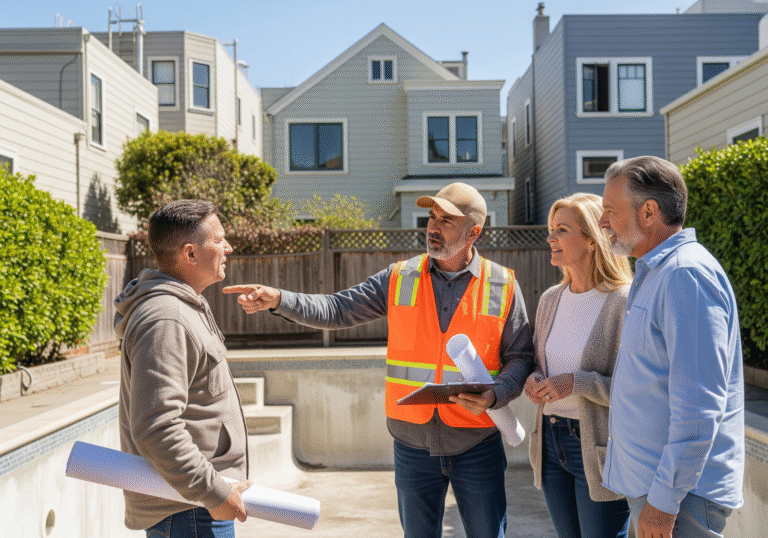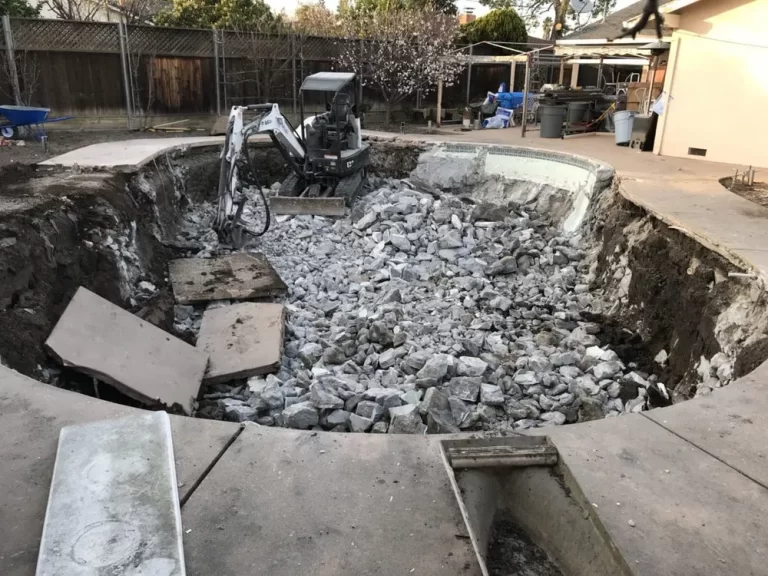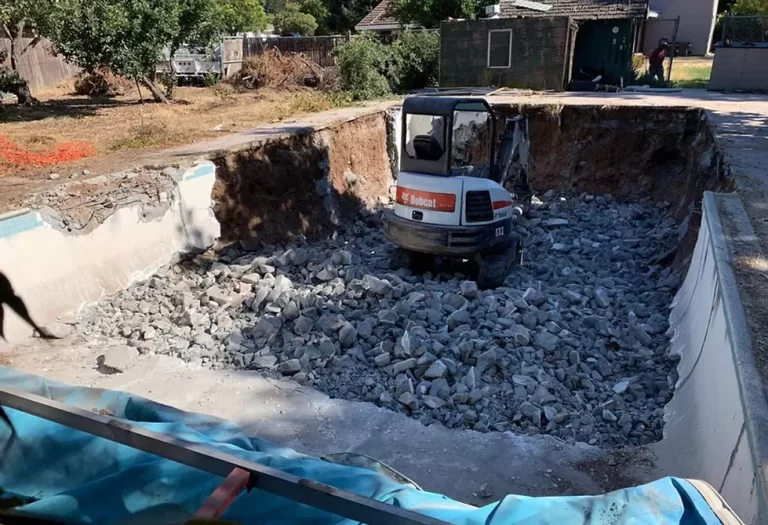Creating an Eco-Friendly Backyard: Start with Pool Removal for Sustainability
Many homeowners are exploring ways to make their backyards more eco-friendly. One critical step is removing an old pool that no longer serves its purpose. Replacing an unused pool with natural landscaping can significantly enhance sustainability and lower environmental impact.
Pool removal reduces water usage, cuts down on chemical runoff, and frees up space for gardens or native plant habitats. By doing this, yard space, which was once occupied by a water-hungry pool, transforms into an area that supports local wildlife and promotes biodiversity.
Sustainable living isn’t just about the choices made inside the home. Creating an eco-friendly backyard encourages a balanced ecosystem right outside the door, offering both environmental benefits and a serene natural retreat.
Understanding Pool Removal
Removing a pool can greatly reduce environmental impact and save on long-term costs. Pool removal involves careful planning, equipment use, and considering the aftermath, like landscaping changes.
Environmental Impact of Pools
Pools can harm the environment. They use a lot of water, which is important to save, especially in dry areas. Pools also need chemicals to prevent algae and bacteria. These chemicals can be dangerous if they enter the ground or water supply. Moreover, pools often use electricity for filters and heaters.
Reducing such energy use and chemical dependency helps the environment. When a pool is removed, there is more space for native plants, which support local wildlife. Transforming pool areas into gardens or green spaces can increase biodiversity. This makes the environment around the home healthier.
Maintenance and Long-Term Costs
Keeping a pool involves high maintenance costs. Routine care includes chemicals, cleaning, and repairs. This regular upkeep can become expensive over time. Equipment like pumps and heaters also need energy, adding to electricity bills.
Inground pool removal eliminates these ongoing expenses. Without a pool, homeowners save on water bills and repairs. Transforming the space might have upfront costs, but it results in financial savings in the long run. This allows homeowners to invest in eco-friendly landscaping or other sustainable home improvements.
Benefits of Pool Removal for Eco-Friendliness
Removing a pool can lead to significant eco-friendly benefits by conserving water and reducing energy use. It encourages the use of sustainable practices that benefit the environment.
Water Conservation Efforts
Pools require lots of water. Filling a standard-sized pool can use over 20,000 gallons of water. Pool removal helps decrease water waste, allowing this resource to be used more wisely.
In dry climates, conserving water is very important. Removing a pool supports water-saving practices like rainwater harvesting. Collecting rainwater helps irrigate gardens and can reduce dependency on municipal water supplies.
Reducing water use also means less water treatment. Chemical treatments used in pools can have harmful effects on local ecosystems. Less dependency on these chemicals makes the surrounding environment healthier and cleaner.
Reduction in Energy and Resource Usage
Pool maintenance demands energy. Many pools use electric pumps and heaters, increasing energy consumption. By eliminating pools, energy use goes down, resulting in reduced electricity bills and a smaller carbon footprint.
Alternatives, like solar pool heaters, are sustainable, but removing the pool entirely maximizes energy conservation. Fewer resources mean less reliance on non-renewable energy sources.
The removal also permits the installation of energy-efficient elements. Plants and eco-friendly landscaping can replace pools. This adds greenery, aids in improving air quality, and provides habitat for local wildlife, promoting a healthy and sustainable backyard environment.
Reclaiming Your Space
Removing a pool opens up lots of possibilities for creating a greener backyard. By focusing on sustainable design and calming outdoor areas, homeowners can make their yards more eco-friendly and relaxing.
Designing Sustainable Landscapes
Once the pool is gone, the backyard can transform into a sustainable oasis. Using native plants is key. These plants require less water and care, making them ideal for creating a yard that is both beautiful and eco-friendly. Native plants also boost biodiversity, attracting local wildlife like butterflies and birds.
Landscaping should be planned to make the best use of available space. This approach not only enhances the look but also supports sustainable practices. Implementing rainwater collection systems and installing solar garden lights are great ways to further enhance sustainability. Offering a list of drought-resistant plants and eco-friendly features can help guide these choices.
Integrating Relaxation Zones and Gardens
After removing the pool, there’s new room to add relaxing areas and gardens. Consider turning part of the space into a garden oasis. This can include a variety of plants and trees to provide shade. Strategic placement of seating, such as benches or hammocks, encourages relaxation.
Adding a vegetable garden is another great option. It provides fresh produce and reduces the need for packaged goods, which supports a healthier lifestyle and reduces waste. Combining these elements converts the space into an inviting and sustainable retreat, ideal for spending time outdoors with family and friends.
Planning Your Eco-Friendly Backyard
Creating an eco-friendly backyard involves thoughtful planning. By focusing on native plants and sustainable hardscaping, homeowners can reduce their environmental impact and create a sustainable outdoor space.
Incorporating Native Plants and Biodiversity
Choosing native plants is essential for an eco-friendly backyard. These plants are adapted to the local climate and need less water, reducing reliance on irrigation. They also support local biodiversity, providing habitat and food for pollinators like bees and butterflies.
Adding a variety of plants can create a balanced ecosystem. Consider a mix of flowers, shrubs, and trees that bloom at different times. This ensures that wildlife has access to resources throughout the year. Planting in layers—tall trees, mid-level shrubs, and ground covers—can optimize space and offer shelter to wildlife.
Sustainable Hardscaping and Material Choices
When it comes to hardscaping, sustainable materials are crucial. Using recycled materials like reclaimed wood or composite decking reduces waste. Permeable pavers are another smart choice, allowing rainwater to seep through and return to the soil, helping to manage stormwater runoff effectively.
Choosing local materials can also lessen the environmental impact by reducing transportation emissions. Incorporating features like gravel pathways or mulched areas can further enhance sustainability. These choices not only support the environment but can add unique character to the backyard as well.
Implementation Steps
Removing a pool can create space for gardens and reduce water use. It involves preparing the land and hiring skilled teams. Each step ensures a smoother transition to an eco-friendly yard.
Grading and Preparing the Land
Grading is crucial to manage water flow and prevent flooding. After pool removal, the land must be evened. This involves filling the pool area with soil. Using quality fill soil is essential to avoid future sinking.
Proper grading helps direct rainfall to desired areas like garden beds. This means creating slight slopes. Sometimes, this requires compacting the new soil properly.
Water drainage planning is key. It can stop ponds from forming in your yard after rain.
Choosing the Right Professionals for the Job
Hiring professionals ensures the job is done safely and effectively. Experienced teams know how to handle both partial and complete removal of old pools.
Researching and selecting the right team is important. Consider specialists who have strong local reputations. Review past projects if possible.
Experts can also help with legal requirements. This includes permits needed to remove pools. Licensed and insured companies offer peace of mind, ensuring work is compliant with building codes.
Using trusted services like those found in the Bay Area helps ensure quality work and customer satisfaction.
Alternatives to Traditional Pools
Creating a sustainable backyard often involves rethinking traditional swimming pools. Natural swimming pools and eco-friendly technologies can offer enjoyable and environmentally sound options.
Natural Swimming Pools and Sustainable Water Features
Natural swimming pools are an eco-friendly choice that mimic natural bodies of water. They use plants and beneficial bacteria to filter the water instead of chlorine or other chemicals. This creates a healthier swimming environment and supports biodiversity.
Key Features:
- Bio-filters: Use gravel and aquatic plants for cleaning.
- Separation zone: Part of the pool is set aside for filtration.
- Minimal additives: Keeps water chemical-free and safe.
Sustainable water features such as rain gardens or small ponds can also enhance the backyard. They help manage rainwater and support local wildlife.
Technologies for Water and Energy Efficiency
Technologies in pool design can greatly reduce water and energy consumption. Variable-speed pumps adjust their speed for efficient water circulation, cutting energy use significantly. Solar pool heaters harness sunlight to warm the pool, reducing reliance on electrical heating.
Notable Technologies:
- Variable-speed pumps: Use up to 65% less electricity.
- Solar heaters: Eco-friendly heating solution.
- Efficient covers: Reduce evaporation and heat loss.
Incorporating these technologies makes an eco-friendly pool possible. It ensures enjoyment while minimizing environmental impact.
Safety and Regulations
Removing a pool can open up exciting possibilities for your backyard but also brings safety and regulatory considerations. Understanding legal obligations and maintaining a safe space for the family is crucial.
Navigating Legal Considerations
Homeowners must adhere to local regulations when removing a pool. Many areas require permits, guiding the safe and legal removal of structures. Contacting local authorities helps ensure no legal oversights occur. Speaking with professionals can ease this process.
Hiring licensed contractors familiar with pool demolition can be beneficial. They often manage paperwork and ensure compliance with all rules. This reduces the homeowner’s burden and helps avoid fines or penalties for non-compliance.
Creating a Safe Environment Post-Pool Removal
After removing a pool, safety remains a priority. The newly cleared space can be a safety hazard if not properly handled. Filling and leveling the area is vital to prevent issues like unstable ground.
Families should discuss the new layout and potential uses for the space. It’s important to inspect the area for debris that could cause harm. Installing signs or temporary barriers may protect children and visitors until the area is fully refurbished.
Parents may consider adding features like garden fencing to delineate boundaries and ensure continued safety for children and pets.







